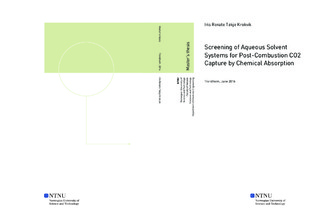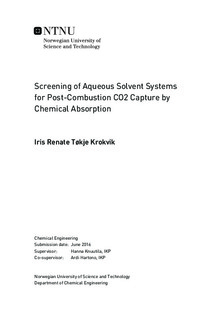| dc.description.abstract | The atmospheric CO2 concentration we see today has likely not been seen before. As carbon dioxide is a strong greenhouse gas, this is a big red flag towards global warming. A higher mean temperature on earth would lead to more extreme weather, sea level rise and increased spread of infectious diseases.
The Paris Agreement, under which nearly 200 countries have committed to trying to limit the global temperature rise this century well below 2 degrees Celsius, has reaffirmed the im-portance of carbon capture and storage to limit carbon emissions. Absorption of carbon diox-ide by amine based solvents is one of the most mature technologies in the portfolio of climate change mitigations. However, CO2 capture is an expensive and energy demanding process, so substantial R&D is directed to reduction of operating costs and other energy saving measures.
It is therefore essential to establish a novel technology for efficient development of new car-bon capture absorbents with optimal properties, and new low energy penalty solvents. In this work a rapid screening apparatus for CO2 absorption has been applied to test absorption char-acteristics of amines, alkanolamines and amino acid salts.
The first objective of the research described in this thesis has been to understand the effect of ratio and molecular structure to MAPA promoted tertiary alkanolamines. Five tertiary amines, 2-diethylamino-ethanol (DEEA), triethanolamine (TEA), N-Butyldiethanolamine (BDEA), 2-(Dibutylamino)ethanol (EDEA) and N-tert-Butyldiethanolamine (t-BDEA) are considered in this work. The influence of amine alkanol groups, as well as alkyl chain structure, is investigat-ed by systematically varying the tertiary amine and the total amine concentration. The experi-ments were conducted using three different 3° amine/MAPA molar ratios, 3:1, 2:1 and 1:1. The total amine concentration was kept constant at 4 mol/L. In addition the single 3° amines are run at 3M and MAPA at 1M.
The second objective was to cross-validate a model for predicting a compounds basicity, and thereby its ability to absorb carbon dioxide. The commercially available compounds selected for cross-validation are 1,2-Diaminocyclohexane (DACH), N-Benzylmethylamine (BMA), N,N-Dimethylbenzylamine (DMBA), Phenethylamine, Creatine and L-Arginine (ARG).
All screening experiments was compared to the benchmark solvent, 30 wt. % monoethanolamine (MEA). 3M and 4M MEA was used for comparison according to total amine concentration of the blends. The effect as promotor was compared against 3M DEEA+1M MAPA.
Two liquid samples were collected from the screening experiments, one after absorption and one after stripping. The CO2 and amine content in these samples, was determined by potensiometric titration, in order to verify the vapor/liquid mass blance. The results showed large discrepancies between liquid analysis and screening data of lean loadings, ranging from 11-513 %. Single tertiary amine systems, with low reactivity, gave the largest deviations.
The screening results indicate that the number of amine alkanol groups affect the system adversely, and lower the absorption capacity. The alkyl chain structure have small negative effect on the absorption rate, as increasing alkyl chain decrease the absorption potential. Addition of hydroxyl groups was found to decrease the absorpion capacity. MAPA is working excellent as a promoter and enhance both reaction rate as well as absorption capacity. The absorption capacity increase with increasing amount of MAPA.
The most promising tertiary amine/MAPA system was 2M DEEA+2M MAPA, with an absorption capacity of 3.31 mol CO2/kg amine and cyclic capacity of 1.92 mol CO2/kg amine.
The six non-alkanolamines show poor performances overall. They show various issues with foaming, vapor pressure and phase-separating. 30 wt. % BMAs absorption rate is similar to 1M MAPA and 30 wt. % MEA, but exhibit a low absorption capacity (1.24 mol CO2/kg amine). As a promoter to 3M DEEA, the 3M DEEA+1M BMA system performed worse than 3M DEEA alone, but with a higher absorption rate. The cyclic capacity for 3M DEEA+1M BMA is 0.36 mol CO2/mol amine. 14 wt. % L-Arginine exhibit a higher absorption rate and absorption capacity than BMA, but a low cyclic capacity (0.22 mol CO2/kg amine). As a promoter to 3M DEEA, the blend had the same performance as 3M DEEA alone, but with a somewhat higer absorption rate. 3M DEEA + 5 wt. % ARG achieve a rich loading of 2.08 mol CO2/kg amine and a cyclic capacity of 1.70 mol CO2/kg amine. | |

